The Sparta You've Never Heard About - Part I
From Archaic Sparta [Intro] to the reforms of Agis IV.
Introduction
Since you are reading this, I’d bet that you have heard of ancient Sparta. The 300 of Gorgo and Leonidas vs rhino-riding ninja Arab-Persians. Maybe highly trained citizen-soldiers, Helot slaves and the Peloponnesian Wars. Classical Sparta is famous, in some ways. Later Sparta though is left off mainstream historical discussion - and interestingly, but not surprisingly - schoolbooks in modern Greece. While not a major power anymore, Hellenistic Sparta still came very close to resurgence. Unique social dynamics, ruthless class war, crazy plots and power diplomacy make the times of late Spartan reformer kings into an excellent and educational story. Before we go there though, let's get into some historical background.
The Spartan Constitution
At some point in the Archaic Period (c. 800 BC according to Thucydides), Lycurgus gave Sparta the basis of it's unique unwritten law. Though changing with time, Spartan hierarchy can be approximately described as the following:
Sparta had two kings without absolute powers, mostly functioning as military and foreign policy leaders. The Agiad and Eurypontid dynasties each provided one king.1
The Ephors (overseers) and the Gerousia (council of elders, including the two kings), 5 and 30 respectively, held a lot of power, making Sparta a mix of an oligarchy and a diarchy.
Spartan male citizens (Homoioi, or “those who are alike”), had full rights and the obligation to live and train in military barracks from age 7 to 30. This system was called the Agoge, focused on teaching austerity, wit, martial prowess and discipline.
Spartan female citizens were in relatively good standing, underwent physical training and the richest of them owned large estates.
The Perioikoi (free non-citizens living around Sparta), Mothakes and Hypomeiones (semi-Spartans due to lineage, punishment or dire poverty) didn't have full rights, but were called to arms in times of war.
The Helots were state-owned serfs with minimal rights, practically slaves. They were a sizable majority of the total population. The Krypteia military police kept them in check, often through terror and unprovoked murders. At times, some Helots (Neodamodeis) would gain freedom in exchange for military service.
Spartan Timeline, Archaic to Early Hellenistic Period
Archaic Sparta
743-724 BC: First Messenian War. Sparta defeats and occupies neighboring Messenia, turning those who don't escape into Helots.
c. 680-660 BC: Second Messenian War. Messenian Helots revolt with help from nearby states. The conflict lasts for about 10 years, until Sparta prevails again. Some Messenians flee to Italy.
669 BC: Battle of Hysiae. Argos defeats Sparta and checks its expansion. Possible date for the invention of hoplite warfare by the Argives, leading to its adoption by the Spartans and other Greeks.
c. 560 BC: After two centuries of struggle Sparta defeats and vassalizes Tegea, one of the strongest Arcadian cities.
546 BC: Battle of the Champions. Sparta and Argos face off at Thyrea. To avoid full scale bloodshed, they agree to each send 300 champions to settle the score. 2 Argives and 1 Spartan survive. Both sides find reasons to claim victory.
511-507 BC: Concerned about Persian expansion, Cleomenes I of Sparta and Athenian nobles lead by Cleisthenes cooperate to depose Hippias, the pro-Persian Tyrant of Athens. This leads to the establishment of the Athenian Democracy - contrary to Cleomenes' effort to establish an allied oligarchy - and a short lived Athenian-Persian alliance.
499 BC: Sparta refuses to aid the Ionian revolt against the Persian Empire.
494 BC: Battle of Sepeia. Cleomenes I defeats the Argives. Sparta dominates Peloponnesian politics.
490 BC: Battle of Marathon. Persia strikes back at Athens after Athenian support of the failed Ionian Revolt. Athens scores a great victory while Spartan aid arrives after the battle.
490/489 BC: Cleomenes I is imprisoned, likely for political reasons, and dies soon. Official narrative is that he
Epsteined himselfwent insane and committed suicide. Leonidas I succeeds him.480-479 BC: Second phase of the Greco-Persian Wars. Leonidas leads the famous last stand at Thermopylae, the Persian fleet is defeated at Salamis and the Persian Army at Plataea.
Classical Sparta
478-460 BC: Spartan focus soon returns to domestic affairs. Athens assumes leadership in the offensive against Persia and forms the Delian League.
464 BC: Earthquake causes thousands of casualties in Sparta, is followed by a failed Helot revolt.
460–445 BC: First Peloponnesian War. Spartan lead Peloponnesian League faces Athens and the Delian League. 30 year peace treaty is agreed in 445 BC.
c. 449–447 BC: Second Sacred War. Sparta removes the Phocians from Delphi, the Phocians soon regain control of the Oracle with Athenian help. Holy wars have always been about politics.
431–404 BC: (Second) Peloponnesian War. Large scale conflict raging from Sicily to the Black Sea. The Spartan alliance defeats the Athenians with Persian help and forces them to accept a short lived oligarchy. Sparta dominates Greece.
401 BC: Sparta supports the failed revolt of Cyrus the Younger in Persia.
396–394 BC: Agesilaus II of Sparta campaigns against Persia in Asia Minor but he is forced to retreat by the following Corinthian War.
395–387 BC: Corinthian War. Athens, Thebes, Corinth and Argos, backed by Persia, revolt against Sparta. Persia reintegrates the Anatolian Greeks, Sparta dominates its former mainland allies while Athens bounces back to power.
385 BC: Epirus suffers a major Illyrian-Syracusan offensive; Agesilaus II expels the invaders.
379–362 BC: Theban-Spartan War. The Thebans revolt against Sparta and establish a democracy, initially receiving Athenian and later Persian aid. Pelopidas and Epaminondas revolutionize military tactics and score brilliant victories, leading to Theban dominance in mainland Greece. The Spartans lose control of Messenia and Arcadia who form Theban-backed leagues. Megalopolis and Messene are established as checks to Spartan power.
376-374 BC: Athens defeats Sparta in naval battles and regains dominance in the Aegean.
366 BC: Agesilaus II returns to Asia Minor to support revolting Satraps, along with - now friendly - Athenian forces.
362 BC: Thebans and allies defeat Sparta, Athens and allies at Mantinea, but lose most of their remaining competent officers during the battle. Thebes soon diminishes into a local power in Boeotia.
c. 362-358 BC: Agesilaus II in Egypt to back the locals against Persia, dies from old age during his return journey.
359-336 BC: Rise of Macedon under Philip II.
356–346 BC: Third Sacred War. Sparta and Athens support Phocis, who controls Delphi, against Thebes and the Amphictyonic League. Philip II enters the war against the Phocians and defeats them, starting to dominate Greek politics.
346 BC-343 BC: Foreign War. Archidamus III of Sparta checks Knossian ambitions with an expedition in Crete.
342 BC-338 BC: Archidamus III campaigns in Italy to aid Tarentum against local tribes, but dies in battle.
338 BC: Philip II defeats Athens, Thebes and allies at Chaeronea, goes on to form the Hellenic League at Corinth. Sparta refuses to cooperate. Philip threatens that if he attacks Sparta he will destroy it, to which the Spartans reply “If”. Philip raids Spartan territory and grants border regions to Sparta’s local rivals.
333-331 BC: While Alexander III “the Great” campaigns in Persia, Agis III of Sparta cooperates with Persian commanders and leads a number of Peloponnesian States against Macedon. He is defeated at the Battle of Megalopolis by Macedonian regent Antipater and dies in combat, refusing to retreat.
Early Hellenistic Sparta
323-322 BC: Alexander dies in Babylon. An Athenian-lead coalition revolts against Macedon with great initial success, but Sparta refuses to aid. The Macedonian Empire starts to break into - unofficial for now - Successor States.
309–265 BC: Areus I of Sparta introduces coinage, which was forbidden under the laws of Lycurgus2, and attempts to emulate Macedonian/Hellenistic Kings.
c. 303-294 BC: Cleonymus is sent by Sparta with a mercenary force to campaign in Italy and all across the Adriatic Sea.
294-293 BC: Unsuccessful Spartan campaigns in the Peloponnese and Boeotia against Demetrius I Poliorcetes of Macedon.
281–280 BC: Fifth Sacred War. Spartan coalition tries to expel the Aetolians, Macedonian allies, from Delphi. Aetolian victory, soon to be followed by a more important one against the invading Celts. The Aetolian League solidified as a prestigious local power. Meanwhile, the Achaean League was slowly rising in the Peloponnese.
272 BC: While Areus I campaigns in Crete, Pyrrhus of Epirus attempts a siege of Sparta trying to install Cleonymus to the throne. Areus returns and joins Antigonus II “Gonatas” of Macedon against Pyrrhus, who is killed in Argos.
267-261 BC: Chremonidean War. Athens and Sparta, backed by Ptolemaic Egypt with coin, grain and ships attack Macedon. Areus is defeated and killed by Antigonus II near Corinth, who in turn defeats the Ptolemaic fleet and forces Athens to surrender.
261-244 BC: The following Spartan kings further depart from Spartan traditions and increasing follow the new Hellenistic customs. War and corruption have reduced the number of Spartan citizens to a few hundred, making the core of the Spartan military almost non-existent. The vast majority of the Spartan population is poor and disenfranchised. All time low for Sparta so far.
Hellenistic Sparta and The Ancient World War
Entering the late Spartan era, at first we shall describe the deeds of the first two and best known late Spartan kings. Later on, with less information available on Spartan affairs - and great interconnected wars escalating all around Sparta - we will also brief much of the known contemporary Greco-Roman history. From the start of the 2nd Punic and 1st Macedonian Wars, to the end of Spartan independence.
The Reforms of Agis IV (c. 244 - 241 BC)
Agis was a member of the Euripontid dynasty, which had been largely sidelined by the Agiads during the early Hellenistic period. His mother and grandmother were likely the richest folk in town3. Spartan women were allowed to amass personal property, while their men often focused on military and political affairs. By this time, there were around 700 Spartan citizen couples, as opposed to at least 9000 a few centuries earlier. Even worse, only around 100 households owning estates were left, the rest being in poverty and debt. Luxury and vice kept rising in the traditionally austere Spartan society, creating further tensions. What possibly concerned Agis and his ideological successors the most though, was the lack of eligible soldiers.
After their defeats against Thebes and the loss of Messenia - in addition to several border regions and vassals - the Spartans also had a diminished economic base. Lack of manpower and reduced wealth were partly offset by adventuring expeditions. Kings and prominent Spartans served as mercenary leaders or campaigned in search of plunder, and Sparta itself increasingly hired mercenaries. This was a very unstable, and also increasingly less viable prospect, in a world where Rome, Macedon, Carthage, the Seleucids and the Ptolemies were consolidating, and several minor powers were also on the rise. Sparta had available men who could serve as the core of its army, but those were mostly former Spartans with lost rights, other non-citizens and Helots. They had so far served as untrained levies or support troops when needed. The idea was to make a number of them full citizens, give them land and gain their allegiance.
Agis wanted to cancel all debts and restore the Agoge military training which had recently fallen out of use. He planned to turn half of the farmland into 4500 equal land plots to be granted to current and new citizens, and the other half into 15000 plots for the Perioikoi. He was promoting this as a return to the laws of Lycurgus and found a strong support base mostly among poor young men, members of his family, and some indebted landlords. The opposition included most of the powerful Spartans and was lead by his co-ruler, Leonidas II. Leonidas was soon accused of violating the law, as he was married to a foreigner - which was considered illegal - since the time he had lived in the luxuries of the Seleucid court. He was deposed and went into exile, replaced by Cleombrotus II.
Soon though, Lysander, the only Ephor in support of Agis, was in office no more and the Ephors wanted to restore Leonidas. Some of Agis’ supporters convinced him and his co-king Cleombrotus II to appoint new - and more sympathetic - Ephors, which was legal if both kings agreed. One Agesilaus even wanted to assassinate Leonidas, but Agis made sure the former king was protected. Then, Agesilaus, who was Agis’ uncle - and an influential but indebted landlord - proposed cancelling the debts first, as a way to gain further support. The debt records were burned and Agis left Sparta with a military force to support the Achaeans against an Aetolian attack. Agis and the Achaean leader Aratus of Sicyon failed to cooperate; the alliance and campaign were short-lived.
While Agis was away, Agesilaus - having achieved his goals - was delaying the land reform, angering most of Agis’ supporters. Leonidas II was able to return to Sparta without opposition and reorganized his faction. Agis was forced to flee, but he was betrayed and captured in a sanctuary. After a mock trial in prison, he was strangled to death as his supporters were gathering outside. His mother and grandmother were also strangled on his dead body.
Thus he died at the age of 24. His last words supposedly were: "Weep not for me: suffering, as I do, unjustly, I am in a happier case than my murderers."
To Be Continued… (Part II)
In general one king stays home and the other leads troops. More often than not, one king vastly outshines the other politically.
Spartan success and expansionism after the Persian Wars and - especially after - the Peloponnesian Wars, had already altered the old Spartan ways. Coinage was introduced through plunder, foreign aid (diplomatic bribes and proxy war subsidies) and mercenary service (which even included Spartan kings as time went on), but Areus I was the first king to mint true Spartan coins.
(Spoiler Alert)
There are opinions on young Agis being more or less an idealist puppet/frontman for his family and other elders in his faction. It is also possible that his romantizised life account is a product of later times.
It is also likely that Agis’ faction, besides wanting to reorganize Sparta into a military power, wanted to reapproach Ptolemaic Egypt, as evidenced by the short-lived alliance with pro-Ptolemaic Achaea. On the other hand, Leonidas II and his faction appear pro-Seleucid, and the Seleucid Empire is weak at this point in time, probably unable to financially support Sparta, like the Ptolemies had during previous decades (see also the following parts of this series).






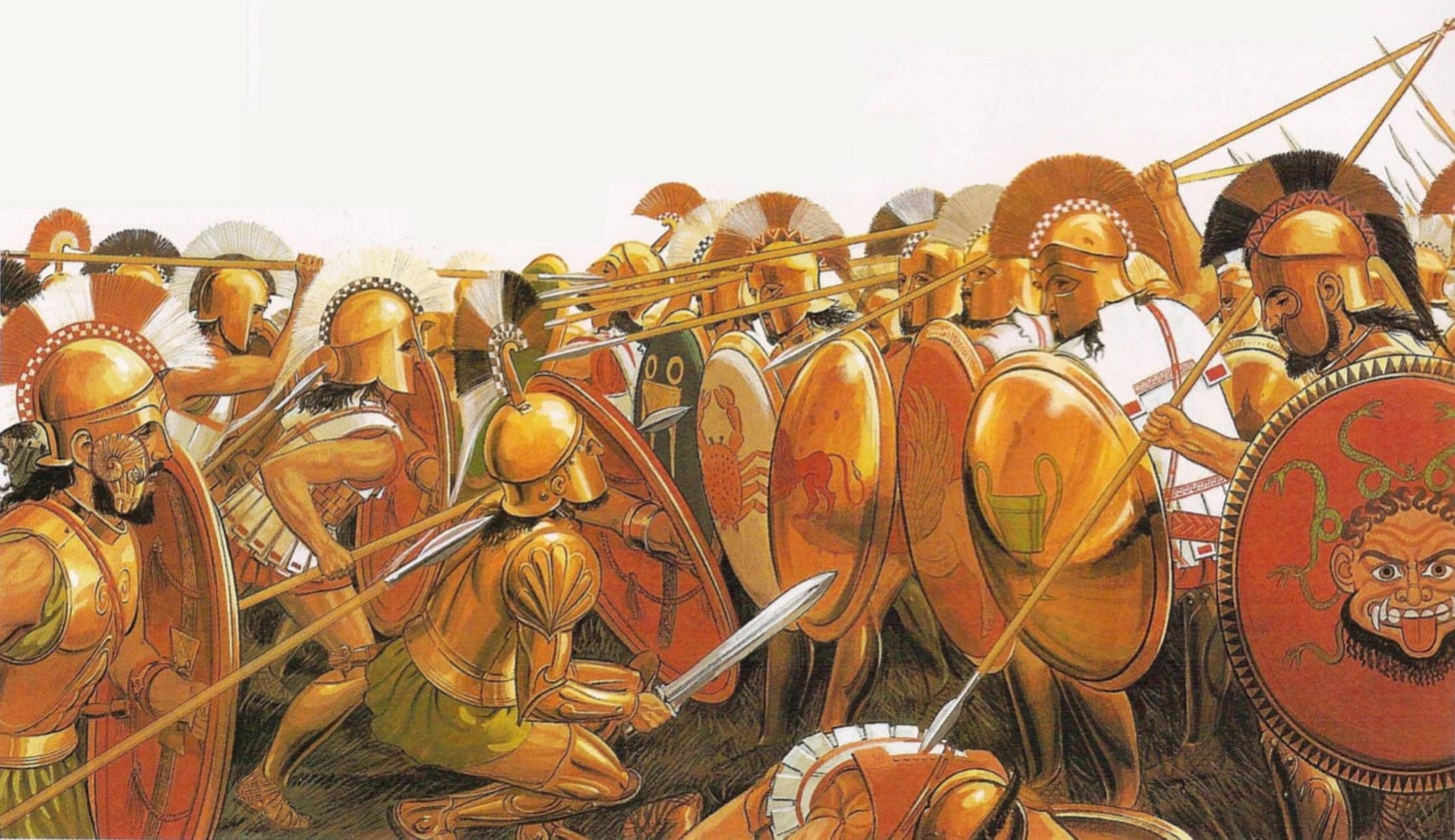
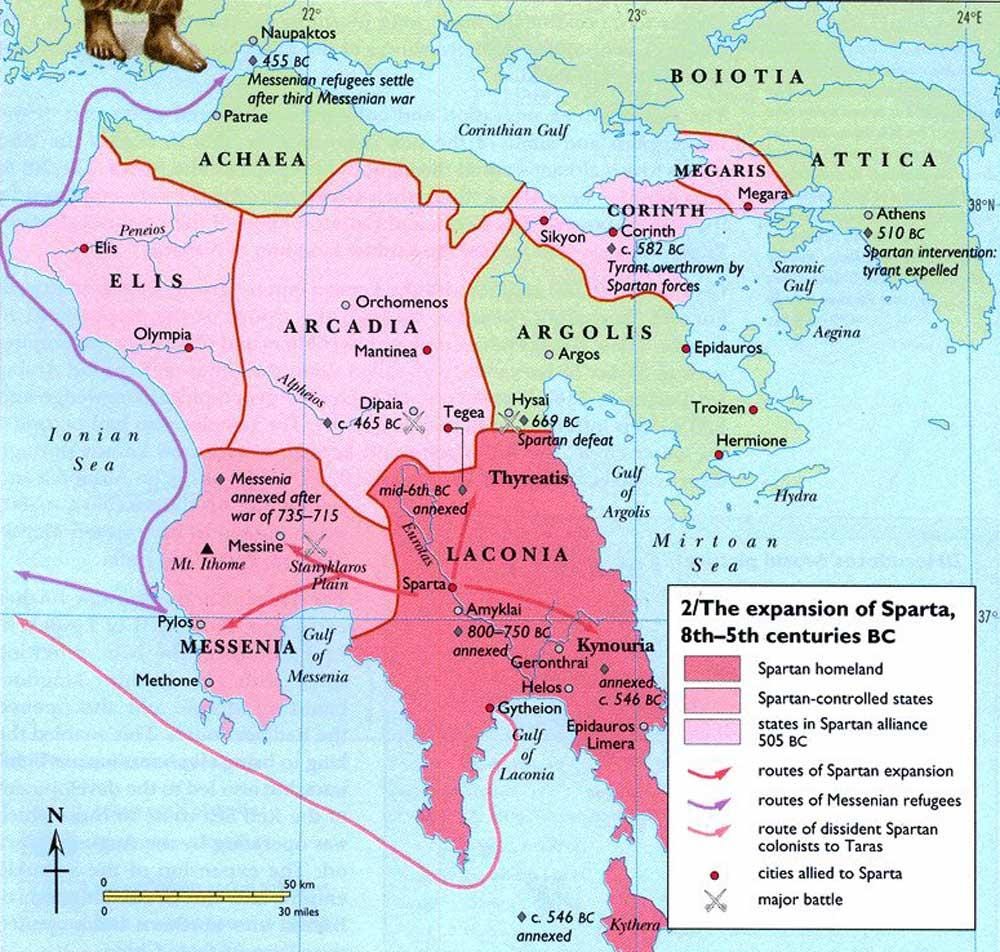




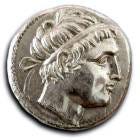
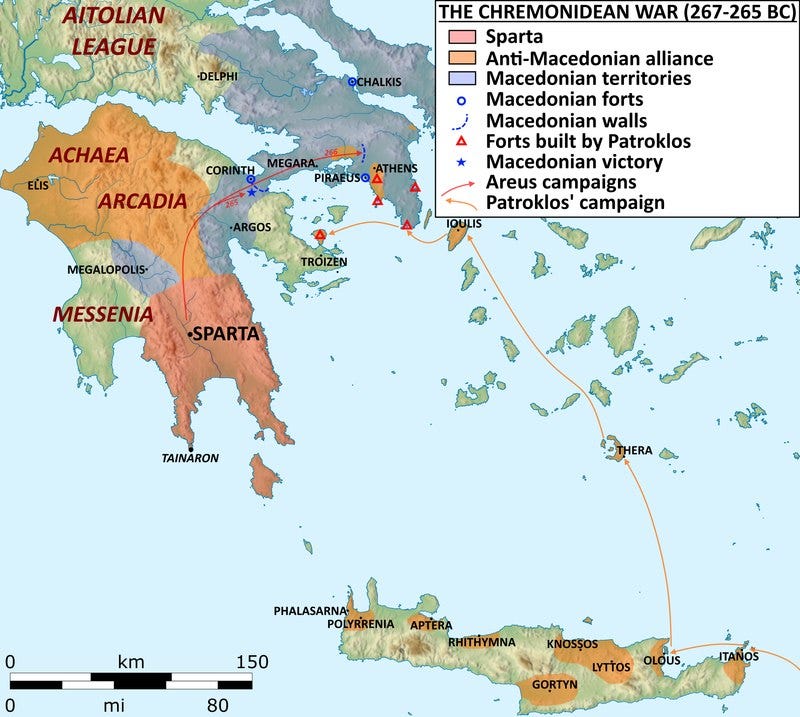
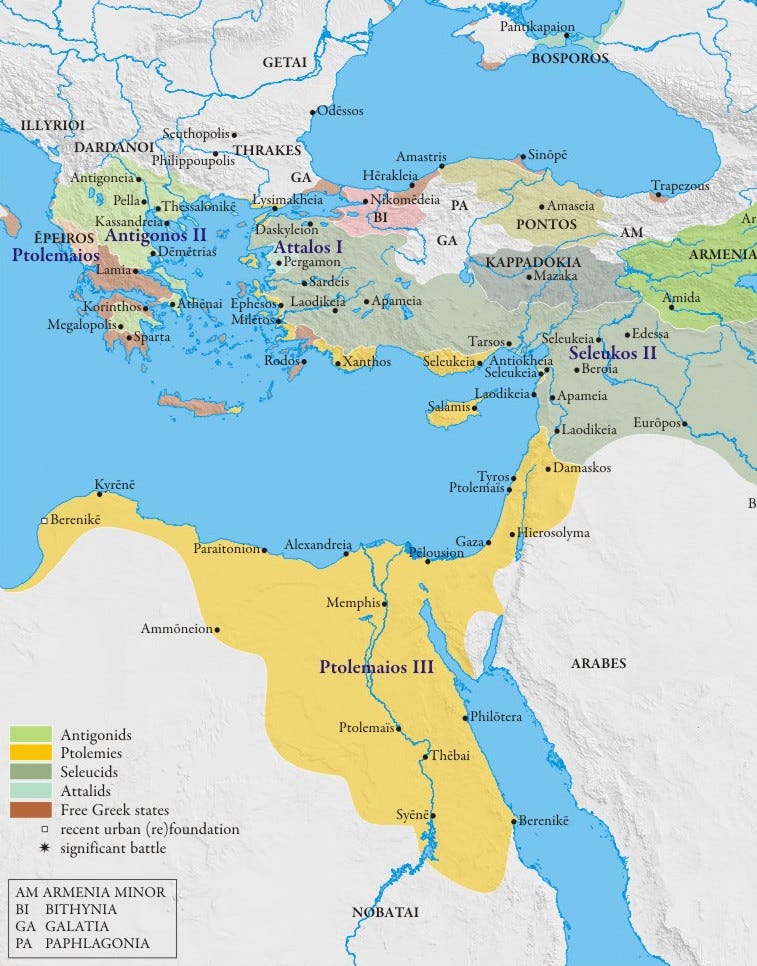

Battle of Marathon. How to get out of fighting is built right into the name.
Hoplite looks like it means the guys in front duck down on their knees so the guys behind can stab their spears over their heads.
Better strategy seems to be to flee to Italy. I mean, this was in the days when you could be sure of getting a good bottle of Italian olive oil that's not all watered down with seed oils.